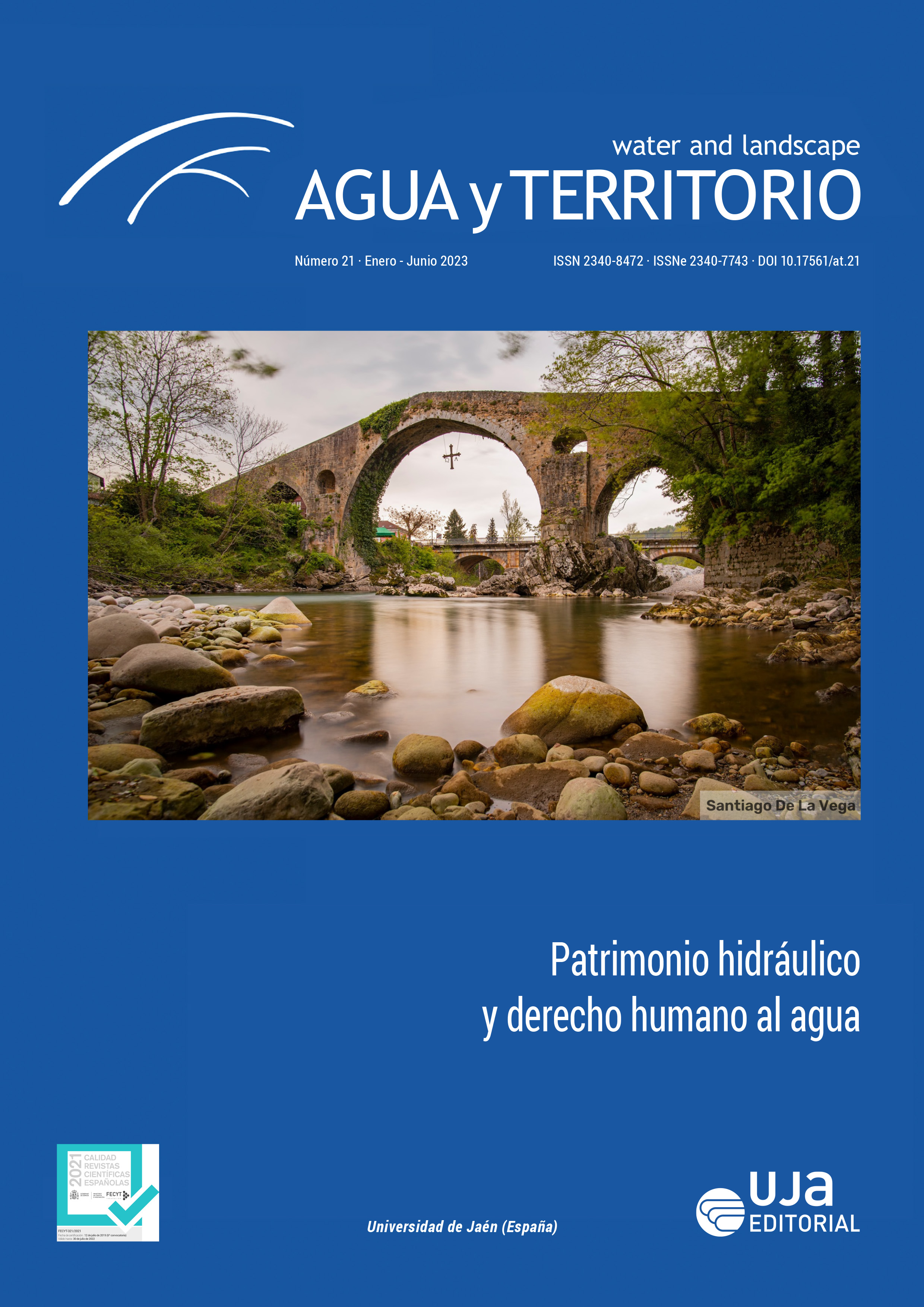Los conceptos científicos y sus implicaciones políticas en la gestión de las aguas transfronterizas México-Estados Unidos: ¿Acuífero transfronterizo o aguas subterráneas transfronterizas?
DOI:
https://doi.org/10.17561/at.21.5738Palabras clave:
Acuíferos transfronterizos, agua subterránea, gestión, Geografía política, México-Estados UnidosResumen
El concepto "acuífero transfronterizo" previsto en la Resolución de Naciones Unidas 63/124 ha tenido un impacto significativo en la evaluación de los acuíferos transfronterizos. En el caso México-Estados Unidos, no ha sido posible determinar oficialmente el número total de acuíferos compartidos, mucho menos se ha podido evaluar el funcionamiento sistémico del agua subterránea, debido a una falta de claridad conceptual en el tema. Esta contribución efectúa un análisis basado en la revisión crítica de evidencia científica y legal para determinar la naturaleza de las discrepancias conceptuales entre las definiciones científicas de "Acuífero Transfronterizo" y "Agua Subterránea Transfronteriza", desde un enfoque interdisciplinario (geografía política e hidrogeología). Los resultados sugieren la necesidad de incorporar una visión sistémica en la gestión de las aguas subterráneas compartidas, así como la homologación de metodologías para garantizar una gestión integrada de las aguas transfronterizas entre ambos países.
Descargas
Referencias
Bredehoeft, J. D., Papadopulos, S. S. & Cooper Jr., H. H. 1982: “Groundwater: the water budget myth”. In Scientific basis of water resource management, Studies in Geophysics, Washington, DC (USA), National Academy Press, 51-57.
Callegary, J. B., Megdal, S. B., Tapia Villaseñor, E. M., Petersen-Perlman, J.D., Minjárez Sosa, I., Monreal, R., Gray, F., Grijalva Noriega, F. 2018: “Findings and lessons learned from the assessment of the Mexico-United States transboundary San Pedro and Santa Cruz aquifers: the utility of social science in applied hydrologic research”. Journal of Hydrology: Regional Studies, 20, 60-73. https://doi.org/10.1016/j.ejrh.2018.08.002
Callegary, J. B., Minjárez Sosa, I., Tapia Villaseñor, E. M., Dos Santos, P., Monreal Saavedra, R. Grijalva Noriega, F. J., Huth, A. K., Gray, F., Scott, C. A., Megdal, S. B., Oroz Ramos, L. A., Rangel Medina, M., & Leenhouts, J. M. 2016: San Pedro River Aquifer Binational Report. International Boundary and Water Commission, Universidad de Sonora, CONAGUA, University of Arizona, U.S. Geological Service.
Carmona Lara, M. C., Carrillo-Rivera, J. J., Hatch-Kuri, G., Huizar-Álvarez, R. y Ortega-Guerrero, M. A. 2017: Ley del agua subterránea: una propuesta. Ciudad de México, (México), Universidad Nacional Autónoma de México.
Carrillo-Rivera, J. J., Peñuela-Arévalo, L., Huizar-Álvarez, R., Cardona Benavídez, A., Ortega-Guerrero, M.A, Vallejo Barba, J. y Hatch-Kuri, G. 2016: “Conflictos por el agua subterránea”, en Moncada Maya, J. O. y López López, A. (Coords.), Geografía de México: Una Reflexión Espacial Contemporánea, Tomo 1, Ciudad de México (México), Universidad Nacional Autónoma de México, 151-166.
Castro, J. E. 2007: “El estudio interdisciplinario de los conflictos por el agua en el medio urbano: una contribución desde la sociología”. Cuadernos del CENDES, 24 (66), 21-46.
Da Franca, N. 2012: “Informe final”. Consulta Regional América Latina y el Caribe. 18 al 20 de abril de 2012. Montevideo (Uruguay), FAO, GEF, AIH, UNESCO-PHI, BM.
Garza, S., Carrillo-Rivera, J. J. y Huizar-Álvarez, R. 2018: Coloquios sobre el Agua Subterránea en México. Ciudad de México (México), Senado de la República, LXIII legislatura.
Han, Z., He, J. & Niu, I. 2010: “Transboundary aquifers in Great Mekong river basin”, in Challenges and New Directions: Proceedings of Isarm 2010 International Conference Transboundary Aquifers. Paris (France), UNESCO-IHP, 55-58.
Hatch-Kuri, G. 2017a: Paso del Norte: La competencia por las aguas transfronterizas. Ciudad Juárez (México), El Colegio de Chihuahua-Universidad Autónoma de Ciudad Juárez. https://doi.org/10.17561/at.13.4121
Hatch-Kuri, G. 2017b: “Agua subterránea y soberanía interdependiente: el caso de los sistemas acuíferos transfronterizos en la región binacional de Paso del Norte”. Norteamérica, 12 (2), 113-145.
Hatch-Kuri, G. 2018: “A joint management of transboundary aquifers: from asymmetries to environmental protection”. Frontera Norte, 30 (59), 129-154. https://doi.org/10.17428/rfn.v30i59.1130
Hatch-Kuri, G. 2019a: “Cumbre Binacional sobre Aguas Subterráneas Transfronterizas México-Estados Unidos. Tech20 Center, El Paso, Texas, 10 y 11 de abril”. Investigaciones Geográficas, 99, 1-3. https://doi.org/10.14350/rig.59965
Hatch-Kuri, G. 2019b: “Toward comprehensive groundwater management in Mexico.Dossier”. Voices of Mexico, 108, 57-58.
Hatch-Kuri, G., Carrillo-Rivera, J. J. & Huizar Álvarez, R. 2019: “Evaluación crítica del acuífero transfronterizo Río San Pedro”. Regions and Cohesion, 9 (1), 61-85. https://doi.org/10.3167/reco.2019.090106
International Groundwater Resources Assessment Center (IGRAC), 2018: Population and areal statistics for 199 Transboundary Aquifers. Delft (Holland), International Groundwater Resources Assessment Center.
Linton, J. & Budds, J. 2014: “The hydrosocial cycle: defining and mobilizing a relational-dialectical approach to water”. Geoforum, 57, 170-180. https://doi.org/10.1016/j.geoforum.2013.10.008
Moreira, R. (2010). Para onde vai o pensamento geográfico?: por uma epistemologia crítica. São Paulo (Brasil), Editora Contexto.
Pétré, M. A. & Rivera, A. 2015: Synthesis of knowledge of the milk river transboundary aquifer (Alberta, Canada-Montana, U.S.A.). Montreal (Canadá), Natural Resources Canada. https://doi.org/10.4095/295754
Ribeiro, W. C. 2010: “Geografia política e gestão internacional dos recursos naturais”. Estudos avançados, 24 (68), 69-80. https://doi.org/10.1590/S0103-40142010000100008
Rivera, A. 2019: “What is the future of groundwater?”. Groundwater, 57 (5), 661-662. https://doi.org/10.1111/gwat.12902
Rivera, A. & Candela, L. 2018: “Fifteen-year experiences of the internationally shared aquifer resources management initiative (ISARM) of UNESCO at the global scale”. Journal of Hydrology: Regional Studies, 20, 5-14. https://doi.org/10.1016/j.ejrh.2017.12.003
Russell, H.F., & Priebe, E. H. 2017: Regional-scale groundwater geoscience in Southern Ontario: Ontario Geological Survey, Ontario (Canada), Geological Survey of Canada and Conservation Ontario Open House. https://doi.org/10.4095/299750
Sanchez, R. & Eckstein, G. 2017: “Aquifers shared between Mexico and the United States: management perspectives and their transboundary nature”. Groundwater, 47 (4), 495-505. https://doi.org/10.1111/gwat.12533
Sanchez, R., Lopez, V. & Eckstein, G. 2016: “Identifying and characterizing transboundary aquifers along the Mexico-US border: An initial assessment”. Journal of Hydrology, 535, 101-119. https://doi.org/10.1016/j.jhydrol.2016.01.070
Sanchez, R., Rodriguez, L. & Tortajada, C. 2018: “The transboundariness approach and prioritization of transboundary aquifers between Mexico and Texas”. AMBIO A Journal of the Human Environment, 41 (7), 760-770. https://doi.org/10.1007/s13280-018-1015-1
Smith, N. 2010: Uneven development: Nature, capital, and the production of space. Athens (Georgia), University of Georgia Press.
Swyngedouw, E. 2009: “The political economy and political ecology of the hydro-social cycle”. Journal of Contemporary Water Research & Education, 142 (1), 56-60. https://doi.org/10.1111/j.1936-704X.2009.00054.x
Tóth, J. 1999: “Groundwater as a geologic agent: an overview of the causes, processes, and manifestations”. Hydrogeology Journal, 7 (1), 1-14. https://doi.org/10.1007/s100400050176
United Nations General Assembly (UNGA). 1997: Resolution 51/229. Convention on The Law of the Non-Navigational Uses of International Watercourses. United Nations. https://treaties.un.org/doc/source/docs/a_res_51_229-eng.pdf Consulta realizada el 20 de enero de 2020.
United Nations General Assembly (UNGA). 2009: Resolution 63/124. The Law of Transboundary Aquifers. United Nations. https://digitallibrary.un.org/record/643188?ln=es Consulta realizada el 20 de enero de 2020.
United Nations General Assembly (UNGA). 2010: Resolution 64/692. Water, Peace And Security: Transboundary Water Cooperation. United Nations. https://undocs.org/pdf?symbol=en/a/64/692 Consulta realizada el 20 de enero 2020
United Nations Economic Commission for Europe (UNECE). 1992: Convention on The Protection and Use of Transboundary Watercourses And International Lakes. https://unece.org/fileadmin/DAM/env/water/pdf/watercon.pdf Consulta realizada el 20 de enero de 2020.
United Nations Economic Commission for Europe (UNECE). 2014: Model Provisions on Transboundary Groundwaters. Geneva (Switzerland), United Nations Economic Commission for Europe. https://unece.org/environment-policy/publications/model-provisions-transboundary-groundwaters Consulta realizada el 20 de enero de 2020.
United Nations Educational, Scientific and Cultural Organization (UNESCO). 2015: Estrategia Regional para la Evaluación y Gestión de los Sistemas Acuíferos Transfronterizos en las Américas. Montevideo (Uruguay), UNESCO. https://unesdoc.unesco.org/ark:/48223/pf0000235394 Consulta realizada el 20 de enero de 2020.
WWAP (World Water Assessment Programme). 2017: Informe Mundial de las Naciones Unidas sobre el Desarrollo de los Recursos Hídricos 2017. Aguas residuales: El recurso desaprovechado. París, UNESCO.
Publicado
Número
Sección
Licencia
Derechos de autor 2022 Gonzalo Hatch Kuri, José Joel Carrillo Rivera

Esta obra está bajo una licencia internacional Creative Commons Atribución 4.0.
© Universidad de Jaén
Los originales publicados en las ediciones impresa y electrónica de esta Revista son propiedad de la Universidad de Jaén siendo necesario citar la procedencia en cualquier reproducción parcial o total.
Salvo indicación contraria, todos los contenidos de la edición electrónica se distribuyen bajo una licencia de uso y distribución “Creative Commons Reconocimiento 4.0 España” (CC-by). Puede consultar desde aquí la versión informativa y el texto legal de la licencia. Esta circunstancia ha de hacerse constar expresamente de esta forma cuando sea necesario.














